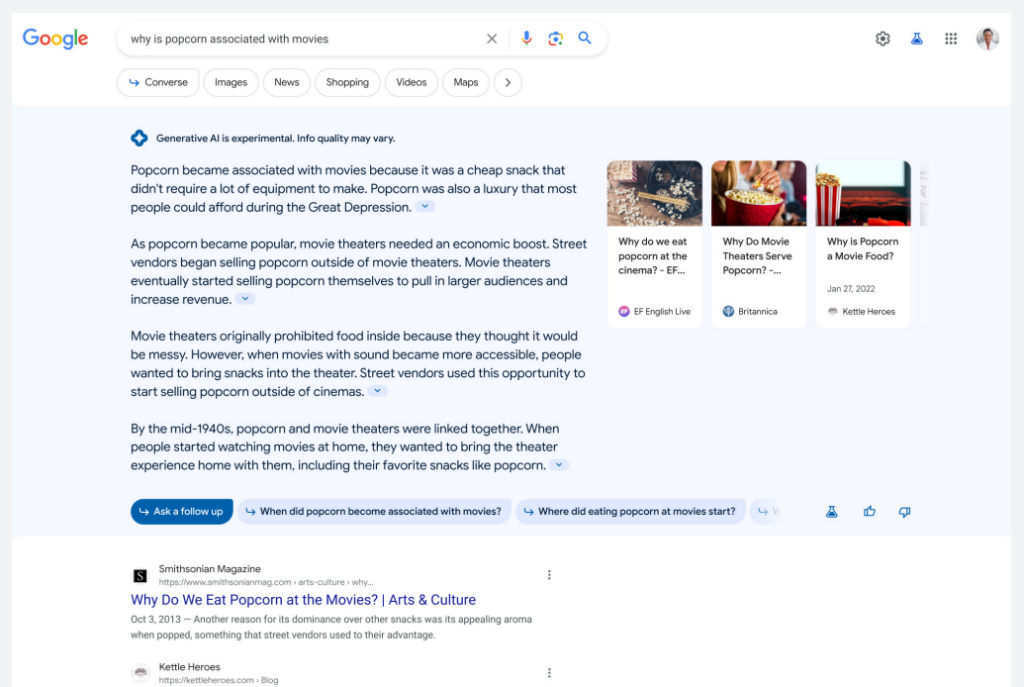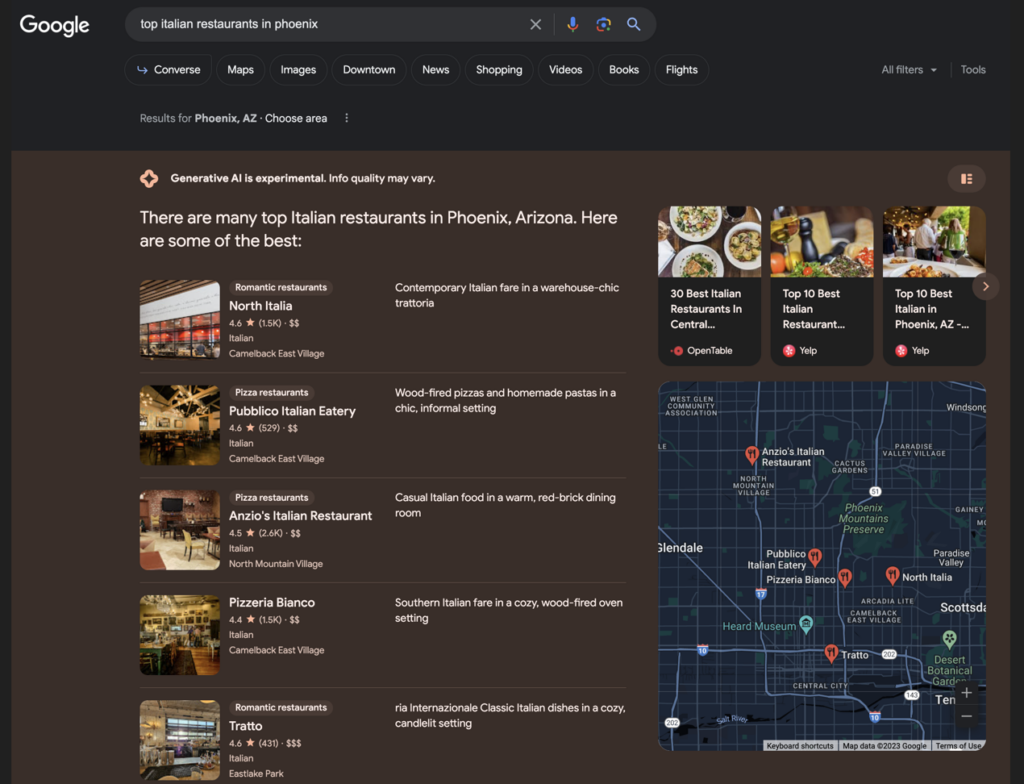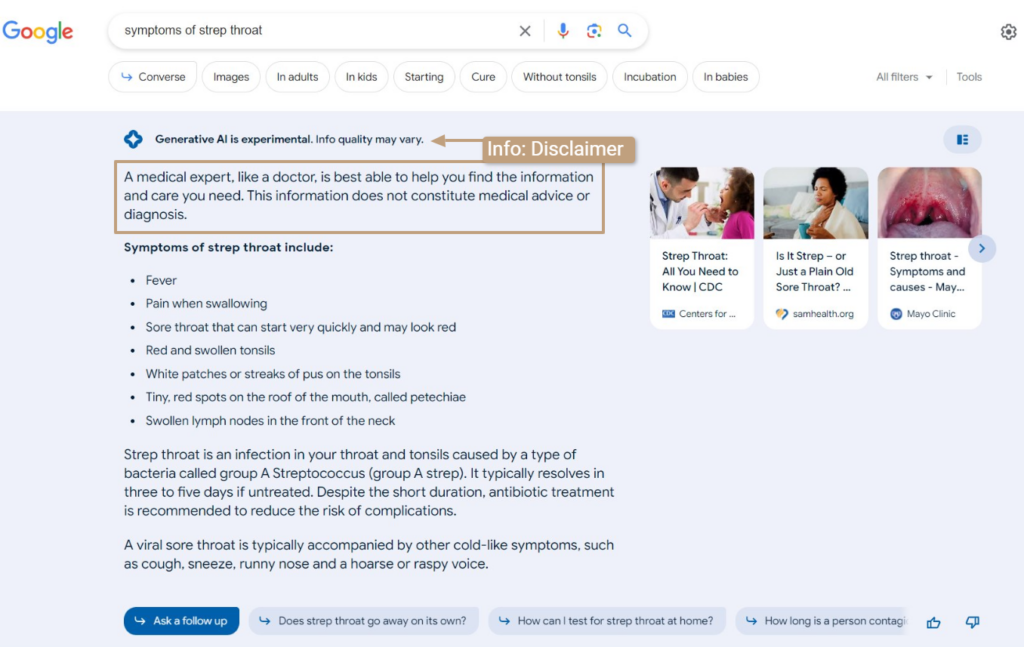Google SGE, or Search Generative Experience, is a new AI-driven search experience that promises to significantly affect search results.
It was introduced by Google at the Google I/O event on May 10, 2023, marking the company’s advancement in integrating artificial intelligence into its most popular tool.
With the introduction of SGE, Google seeks to respond to the paradigm shift posed by generative AI and the threat of ChatGPT.
For us digital marketing professionals and SEO experts, SGE represents an important change in the field of search engine optimization.
Below we explain the keys to this change and what you can expect.
What is Google SGE?
Google SGE (Search Generative Experience) is the Mountain View giant’s bet on integrating generative artificial intelligence with web search.
It will allow users to ask questions in natural language and receive detailed, contextualized responses, suggestions, and links to the most relevant results.
One of the main advantages of SGE is its more conversational approach.
Users can interact dynamically with the tool, obtaining responses that resemble a real conversation. By merging the features of a chatbot and a conventional search engine, Google Search Generative Experience offers a more intuitive and valuable search experience.
This facilitates access to accurate and relevant information efficiently, enriching the interaction between the user and the search platform.
This is at least what Google announced, later we will check how well this ideal aligns with reality.

How Does Google Search Generative Experience (SGE) Work?
The engine powering this generative Google search experience is its PaLM 2 language model along with an advanced version of MUM, which are used to process and understand user queries, trying to return accurate, useful and contextualized responses.
Google SGE has two main modes of use:
- Snapshot, which is usually the default.
- And conversational mode, when you want to dig deeper.
Let’s see what each of them offers:
Snapshot Mode
This mode provides an AI-generated synthesis when an appropriate search is detected, offering a quick summary of relevant information.
In this mode, SGE can provide direct answers and also include images, videos, and links to sources for further exploration.

Conversational Mode
Conversational mode is activated with specific topic questions or by selecting suggested questions, allowing more dynamic interaction.
In this mode, SGE retains the context of previous queries to help users refine or reframe their searches.
Providing a more interactive and fluid search experience.

Types of Searches and Results in Google SGE
Depending on the type of query we make to Google’s new AI search, it will return one type of result structure or another.
Just as highlighted snippets adjust to the search type in traditional search, something similar happens in SGE.
1. Shopping Searches in SGE

In the case of shopping, generative AI helps uncover key considerations and product information. Making faster, simpler purchasing decisions for the user.
Thus, for product searches, SGE generates a summary of notable factors to consider, and provides product options with descriptions including updated reviews, ratings, prices, and images, thanks to integration with the Google Shopping Graph.
As we can see in the screenshot above.
2. Informational Searches

Informational results in SGE can be direct questions or general searches.
SGE generates a page similar to a featured snippet, with an AI-generated text list in response to the query. This list includes dropdown arrows linking to source websites, and a carousel shows links to other relevant websites.
The problem, in our view, is that it seems there are clickable links when there really aren’t. Leaving the experience a bit lackluster.
That is, without being able to access the original sources where Google extracts that information.
Something that prevents the user from continuing to browse and the creator of the information from receiving a visit.
3. Local Search in Google SGE

SGE provides context about locations or places through the use of AI, making it easier for users to compare and explore options.
This feature helps people efficiently obtain relevant information about sites. In principle, providing an enhanced search experience.
And we say in principle because, in practice, this results in a kind of enriched snippet very similar to the one existing in traditional organic search. But in fact, sometimes both overlap, and you can see how the criteria for determining positions are different.
Something that can confuse the end user.
4. YMYL Search in Google SGE

For YMYL (Your Money Your Life) queries, SGE places greater emphasis on producing informative answers corroborated by trusted sources.
Including disclaimers in responses on critical topics such as:
- Health.
- Or finances.
Emphasizing the importance of consulting professionals to obtain personalized advice. Therefore, don’t expect the new Google Search to give you a direct answer.
While Google’s new conversational search capabilities are impressive, the company is being cautious when it comes to sensitive issues.
Thus, questions about how to administer medication to a child or invest your life savings, don’t expect an answer generated by artificial intelligence.
Google, for the moment, will be limited to displaying the standard search results it has always shown. Why so much caution? Google sets high standards for providing quality information people can trust, especially for important questions about health, money, and civic duties.
The company wants to favor responses with factual information.
And it fears its artificial intelligence may include snippets of news or studies with unverified information.
So for many sensitive queries, Google will direct you to verified external sources rather than try to summarize an answer on its own.
SEO in Google Search Generative Experience (SGE)
With SGE, SEO faces a new horizon. Websites and content creators will have to adapt to take advantage of SGE’s generative features.
Optimization for AI-based searches, incorporation of relevant metadata, and adaptation to SGE’s preferred content formats will be essential.
In addition, understanding how SGE interprets and generates responses to queries can provide valuable insights to improve online visibility and relevance in search results. Which in turn can improve SERP position.
It will also be necessary to take into account the traffic that this type of response will take away from websites, especially if, as we already saw in the featured snippets, they begin to resolve the user’s search intent without needing to access the source of the information.
There are still many questions to be resolved on this issue.
However, we can already state that creating content that helps users solve their specific problems will be a priority for Google and, therefore, for companies that want to rank.
Otherwise, without specialized and factual information, Google SGE will not have the raw material necessary to feed its results.
Advertising and Ads in Google SGE
In SGE, ads continue to play a crucial role, appearing in dedicated spaces on the page.
Advertisers have the opportunity to reach potential customers during their searches.
SGE maintains a clear distinction between ads and organic results, marking ads with the “Sponsored” label. The ad experience will continue to evolve based on testing and learning obtained from user interaction.

Limitations of Google Search Generative Experience
Not everything is perfect in the new Google Search. SGE has certain limitations, such as:
- Misinterpretation of data.
- Misrepresentation of information.
- Biased results.
- And contradictions with other search features.
It can also display opinion content, giving the misleading impression that the model has a personality.
Efforts are being made to correct these limitations through model updates and user feedback during the experimental phase, with the goal of improving the quality and accuracy of results generated by SGE.
Another of the most common errors is the duplication of content with traditional search, not providing additional value to the user.
Perhaps this is the most problematic point.
In addition, it is often problematic that many of the sections supposedly intended to cite references or sources from which it obtains information are not really so.
Adding some confusion for the user.
Finally, although Google has been tweaking it little by little, Google SGE can give controversial information on sensitive topics.
Until recently, if you asked it for arguments in favor of slavery, it would give answers, now you have to take some similar detour to get the same result.

Or it may be engaging in AI hijacking practices when displaying its results.
Advanced SGE Features
Recently, Google has announced that generative AI can be used within Search Generative Experience to perform two functions:
1.Text creation
SGE offers a feature that helps users get started with written drafts directly from the search platform, facilitating the conceptualization and initial drafting of ideas.
2. Image creation
It will also allow users to generate unique images through generative AI.
For example, they can request a specific image and SGE will provide up to four generated image options to choose from, helping to visualize ideas or find inspiration interactively.
How to Access Google SGE
As you already know, this access is only available in some countries.
To access Google SGE, you can sign up for the Search Labs program, available in English in the United States, Japan and India, by visiting https://labs.google/
The SGE experience is in an experimental phase and is being implemented responsibly, being part of the Search Labs program where users can interact with this new technology and provide feedback to help improve and develop it.
Unfortunately, in principle it cannot be used if you are not in the selected countries or using a VPN, since there is a validation via phone number.
In addition to the VPN, you also need a mobile phone with a US number to be able to access or from the countries mention above.
The Future of Search with Google SGE
Google SGE represents an initial step towards transforming the search experience through the use of generative AI.
Although it is in an experimental phase, through the Search Labs program, Google seeks to collect user feedback to further improve and develop this technology. The idea is to evolve and expand SGE’s capabilities.
Which will eventually revolutionize how people interact with and discover information on the web.
Ongoing updates and iterations based on user feedback are crucial to SGE’s development.
These improvements focus on addressing known limitations and enriching advanced features such as text and image creation.
SGE also aims to improve and expand vertical search experiences, allowing users to explore and discover information in specific areas such as shopping or local searches more efficiently and enriching.
As in most similar cases where a new technology comes in to revolutionize the established landscape, it will be time and user acceptance that will determine whether this new search approach by Google is or is not adopted as a new standard.
Bottom Line:
In summary, Google SGE is an exciting new evolution in the search experience, driven by artificial intelligence, that promises to change how we interact with the search engine and affect the visibility of websites online.
It is a development that all digital marketing professionals and Google users must consider adapting to benefit from this new search experience.
Thus, this new search experience has the potential to:
- impact website visibility.
- And organic traffic.
Requiring adapted strategies to take full advantage of the opportunities it offers.
In addition, Google SGE also has significant implications for users, as it seeks to offer a more generative and personalized search experience, especially in areas such as travel, shopping, and family life with children.
Soon we will see it’s real impact on SERPs the following months.I
Frequently Asked Questions
What browsers are compatible with Google SGE?
Using Google Search Generative Experience is possible with the Chrome browser on desktop and through the Google app on Android and iOS.
Are there other AI-based web search engines?
Yes, there are numerous alternatives ranging from Bing Chat, to You.com, Opera, and Perplexity.
Why doesn't Google give everyone access?
Google wants to deploy and test its new features in the safest and most controlled way possible. This way, they can refine their product little by little and offer it to the public much more optimized.
When will it arrive in Spanish-speaking countries?
There is no estimated date for the arrival of Google Search Generative Experience in Spain, although they have announced their intention to gradually expand access worldwide.
Links and Additional Resources
- https://static.googleusercontent.com/media/www.google.com/es//search/howsearchworks/google-about-SGE.pdf
- https://www.youtube.com/watch?v=QpBTM0GO6xI&list=TLGGCy91ScdjTPYwMjExMjAyMw
- https://blog.google/products/search/generative-ai-search/
- https://labs.google/sge/
- https://www.aleydasolis.com/en/search-engine-optimization/a-few-thoughts-on-my-initial-google-sge-experience/
- https://www.searchenginejournal.com/google-sge-ai-overview-examples/487918/
- https://www.theverge.com/2023/5/23/23734609/google-search-generative-experience-sge-ai
- https://x.com/lilyraynyc/status/1694440385949339873?s=20
Co-CEO and Head of SEO at iSocialWeb, an agency specializing in SEO, SEM and CRO that manages more than +350M organic visits per year and with a 100% decentralized infrastructure.
In addition to the company Virality Media, a company with its own projects with more than 150 million active monthly visits spread across different sectors and industries.
Systems Engineer by training and SEO by vocation. Tireless learner, fan of AI and dreamer of prompts.
- Este autor no ha escrito más artículos.

